Bioengineering’s Saaniya Kapur Passionate About Biotech, STEM Outreach
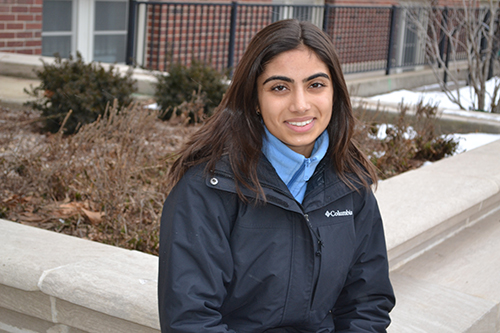
Bioengineering freshman, Saaniya Kapur.
February 8, 2019
Bioengineering freshman Saaniya Kapur’s parents never told her, “Oh, you're too young to do this!” Instead, Mom, who is preschool teacher, and Dad, who is a computer engineer, told her to go for it. So her early love of and exposure to science have shaped her dreams of a career in biotechnology. They have also fueled her passion for STEM outreach. Her goal? To give youngsters, as well as her peers, similar opportunities to fall in love with science the way she has.
It makes sense that Kapur would be passionate about introducing youth to science. She recalls that she “liked science as a kid,” and she “liked hands on.” She had the opportunity to participate in different clubs, plus her school had a mandatory science fair, for which she remembers “working on really extensive projects" with her dad who, according to Kapur, is really interested in how things work, which he evidently passed on to her.
Regarding her parents' input, she recalls, “But they never told me, ‘Oh, you’re too young to do this!’" My dad put me right in the crux of it, saying, ‘Oh, you can do whatever you want at whatever age,’ and I think that’s also given me this idea in my mind that I can do whatever I put my mind to.”
For instance, she remembers as a second grader, doing a project on light refraction and measuring the angle of light refracting. “It was something you wouldn’t expect a second grader to do, and my teacher was like, ‘Ok?!’”
And if Kapur ends up in research, no one should be surprised, given her early experiences. She shares an anecdote about an experiment she cooked up in third grade. Evidently she wore braces and did an experiment to figure out which kind of toothbrush was most effective: an electric toothbrush or a regular one. In fact, she remembers setting up a whole experiment. She had actually wanted to swab her mouth to see how much bacteria was left after brushing, “But of course, you can’t do that at home,” she explains, “so I had to find a creative way.” So she got ahold of some dental staining paper that shows if one is brushing correctly. She would use that, then brush with one toothbrush, then use it again and brush with the other kind. She even had a gradient scale that she would use to rate the color of her teeth. What were the results of her study? An electronic toothbrush does a better job, so she uses one to this day.
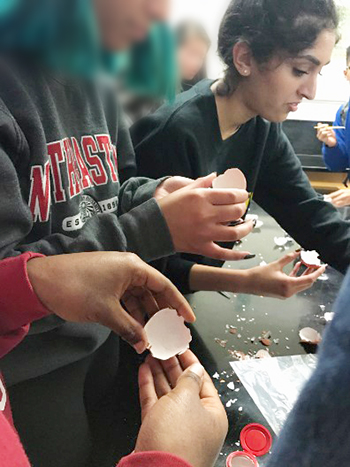
Above: Members of Kapur's high school club do a science experiment making their own geodes, which are small cavities lined with crystals or other mineral matter. (Image courtesy of Saaniya Kapur.)
Below: One of the geodes they made. (Image courtesy of Saaniya Kapur.)
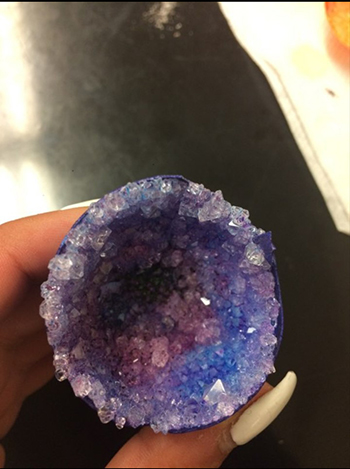
Her passion for science experimentation never waned, so when she reached high school and discovered that it didn’t provide enough science experiments to satisfy her love of hands-on activities, she decided to rectify the omission. Acknowledging that she was “super interested in STEM,” she decided to start a club in order to “introduce fun, STEM-related activities to other students,” explaining, “That's where I found a lot of excitement in science because you got to see the application of what you're learning."
Kapur doesn’t blame the school, claiming it wasn't their fault that there weren't many experiments in the classroom. "You don't have time to do experiments in class when you're an AP-level class," she explains.
Plus, while she was at it, in addition to addressing the absence of hands-on opportunities, she decided to also tackle the dearth of women in science. "If there are other girls out there too who are interested in science like I am,” she told herself, “and they want to do fun activities, I might as well make a club. So my friend and I made the Women in STEM Club in my school."
However, Kapur’s penchant for STEM education outreach wasn’t just limited to high school girls. She was also interested in reaching underserved kids in her community, especially the really young ones. So when the Catholic high school she attended held a community-service-based workshop for its day of service, she and her friends made slime experiment kits for kids in preschool.
"We made them because I know that kids in disadvantaged neighborhoods, the least of their concerns is going to be buying science supplies. We thought that if we packed them before hand, this would allow them the opportunity to actually do this."
Also, because her school strongly encouraged community service, her senior capstone project was based on community service as well. Hers focused on decreasing the educational gap between people of different socioeconomic backgrounds. Plus, she chose to work with preschool kids once again. “My mom’s a preschool teacher, so I think that’s why I really like little kids!” she admits. So she contacted some local preschools about bringing slime kits and introducing their three-year-olds to science. One said yes.
“So I actually performed the experiment with them,” she reports, “and I got to see their little faces. It's so funny when you tell them that this is actually science, because to them, it's just slime. When you actually tell them that this is a chemical reaction that is going on, they ask 'This is science?' because they relate it to something that is just fun."
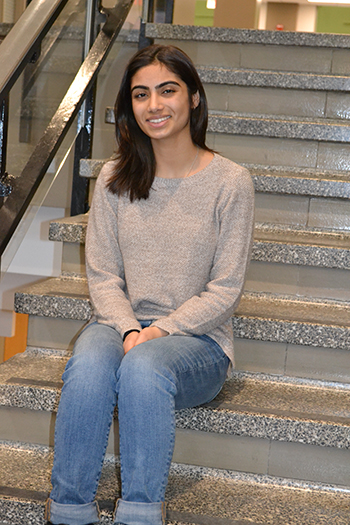
Bioengineering freshman, Saaniya Kapur, on the front steps at Everitt Hall.
Kapur underscores the importance of exposing kids—even three-year-olds—to STEM activities, emphasizing the younger, the better, a belief she no doubt has gotten based on her own early exposure to science and the impact these early exposures have had on her personally.
"I think it's never too early. Because I, from personal experience, am a strong believer that experimenting with what you like, experimenting with different opportunities, you can actually figure out what you like. Because that’s what I’ve been doing all my life. I do one activity. I decide I like it. I further invest myself in that and see that that’s actually my passion.”
Kapur then shares a rather poetic simile, comparing one’s opportunities to a toolbox (an analogy she borrowed from her high school calculus teacher).
“So I feel like with individuals, if you start giving them opportunities at a younger age, as early as possible, you're giving them a lifetime full of different opportunities so that when they reach the point where they decide what they really want to do, they have this entire tool box."
She then went on to share about her calculus teacher who, every time he taught a different chapter, would say, "This is another tool in your toolbox. You can use that your entire life!"
"I look at opportunities the same way," she continues. "You have all of these various types of tools in your tool box, and you can really figure out what you want to make out of your life. The more tools you have, the more possibilities you can make of a career."
.jpg)
Preschool students make slime from the kits Kapur provided.
Kapur admits that's one reason she loves STEM outreach so much: she loves giving youngsters the kinds of opportunities she had as a child.
“That’s why I personally love giving people opportunities, because I was blessed that my parents gave me a lot of opportunities in my life, and that I was able to hone in and really figure out what I wanted to do.”
One opportunity she had that pretty much settled her career trajectory came the summer after her sophomore year. She’s always loved biology, which she says has helped her understand the world better. However, she didn't know a whole lot about biotechnology and bioengineering until she applied to UC Berkeley's Academic Development Talent Program, took a lab-centered, advanced biotech class, and fell in love.
"I got to see all the things you can do with biotechnology,” she explains. “You can do whatever your heart desires."
While she’s pretty much settled on biotech, she’s still trying to figure out her dream job. She’s interested in computation biology (using computer software to analyze large amounts of data from labs), but she’s also interested in tissue engineering, with a humanitarian slant. “Developing countries have a lack of organs,” she says, so if scientists could “grow artificial organs with a person's own cells, there would be no chance of rejections, and no need for organ lists.”
And, of course, despite her busy schedule preparing for her biotech career, she’s never too busy for outreach. In fact, she’s currently a member of the Society of Women Engineers (SWE), and has applied to be an officer on its outreach committee next year. Based on her outreach interests, she should fit right in to SWE’s outreach agenda to high school girls and younger.
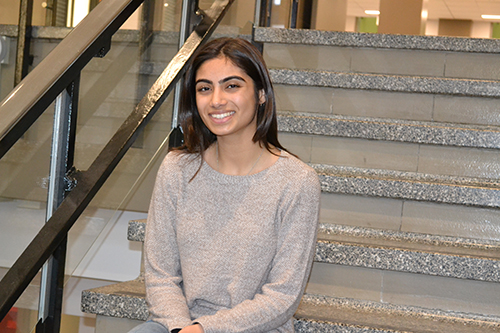
Bioengineering freshman, Saaniya Kapur.
Another reason she’s passionate about STEM outreach is because of its role in helping youth narrow down their career aspirations. "I personally think STEM education is important because it is the foundation for a lot of jobs. You can do a lot of things when you understand the fundamentals, and STEM education does that.”
She also adds that it can help participants discover that they, too, can do STEM.
“But I also think STEM education outreach is incredibly important because I think that in society right now, there is this idea that, ‘Oh, being an engineer or being anything in STEM is extremely difficult—extremely hard. Which it is. But people shy away from it because they think it’s extremely difficult. So doing outreach shows them that 'Yeah, it's difficult, but it's also worth it because look at all these tools it gives you.'"
Story and photos by Elizabeth Innes, Communications Specialist, I-STEM Education Initiative
For more related stories, see: Bioengineering, Student Spotlight, Undergraduate, Women in STEM, 2019













.jpg)
















